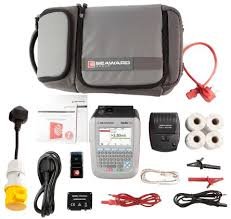PAT stands for portable appliance testing which is one of the major safety checks ensuring that electrical items in any environment such as a business are safe to use. When carried out correctly, using pat test kits can improve accuracy, less risk is taken, and health and safety regulations are met. This article will guide you on the crucial steps you should take to use a pat test kit properly and achieve the desired results.
Understand Your PAT Test Kit
The first step in performing a PAT test is learning how to use the PAT test kit. Depending on the manufacturer, nearly all the test kits are made with multiple parts which include testers, cables, adapters, and even software to record the data. Be sure to read the manufacturers manual thoroughly including information provided on other Pat test pages.
Look for features such as:
- Display and Navigation: Easy-to-read screens and intuitive interfaces help streamline testing.
- Test Capabilities: Ensure the kit supports the types of tests you need, such as earth continuity, insulation resistance, and polarity.
- Data Storage: Modern PAT testers often include memory for storing results, enabling efficient record-keeping.
Prepare for Testing
Once you are ready for testing, create a checklist for all the appliances that have to be checked. This may include the type of appliance, where it is located, and any specific codes that relate to the appliance. This is necessary for order and also that nothing has been forgotten or missed out.
Ensure Proper Calibration
It is appropriate to mention that PAT test kits should be calibrated on a consistent basis so as to give accurate readings. Look at where your device’s calibration reading is and in case it is low to the required level, make arrangements to get a recalibration. It is standard industry practice to do calibration once every year.
Conduct a Visual Inspection
Begin with a thorough visual inspection of the appliance. Look for:
- Damaged cables or plugs
- Signs of overheating
- Exposed wires or frayed insulation
A visual check can often identify faults that testing equipment may not detect, such as mechanical damage or loose connections.
Execute the PAT Testing Process
Step 1: Connect the Appliance
Place the appliance in the tester as the instructions given say so. It is also important to make sure that all connections are made correctly so that the readings are accurate.
Step 2: Select the Appropriate Test
A good majority of PAT test kits are bundled with multiple test options. In this case, opt for a test that best fits the requirements of the appliance in question. Some of the common tests are:
- Earth Continuity Test: Verifies the grounding pathway is intact.
- Insulation Resistance Test: Checks the integrity of insulation materials.
- Polarity Check: Ensures the live and neutral wires are correctly connected.
Step 3: Record the Results
Some contemporary PAT devices show results on their screens. It is advisable to take such readings and compare them with the allowable max limits as set in any safety standard that applies.
Step 4: Label the Appliance
After an appliance has been tested and passed, a sticker showing the status of the tested appliance, the date it was tested and the date it is due for testing is attached to it. This helps everyone detect the safety status at a single glance.
Best Practices for Accurate Results
Use Suitable Settings
Be sure that your PAT test kit fits the type of appliance you are working on. For example, if you are dealing with patent devices like IT equipment market, then only lower test current should be applied so as to avoid damage on such devices.
Avoid Testing in Adverse Conditions
Scorching heat, too much moisture or extreme cold are some of the environmental factors which have the capacity to affect test results. Ensure tests are done in a dry controlled environment at all times possible.
Maintain Your PAT Test Kit
In order for your automatic electrical tester to function well whenever needed, proper care should be maintained. To keep the condition of the device intact, ensure it is cleaned regularly and protected in a case and switch out worn accessories.
Interpret Results Correctly
Interpretations made from the output reports of a PAT tester differ from one person who has been trained to another, hence the difference in reporting. Know how to tell the difference between a non-threatening problem and a serious safety concern, and then make the appropriate choice.
Post-Testing Considerations
Document the Results
Accurate documentation is a vital aspect of PAT testing. Use software provided with your PAT kit to log results electronically, or maintain a manual logbook. Ensure your records include:
- Appliance identification
- Test date and results
- Technician’s signature
Address Faulty Appliances
Any appliances that fail testing must be immediately removed from service. Arrange for repairs or replacement as necessary before retesting.
Plan Regular Testing
Establish a schedule for periodic PAT testing based on the nature of your workplace and appliances. High-risk environments or frequently used equipment may require more frequent testing.
Conclusion
Effective PAT testing comes from proper preparation, attention to detail, and a set of best practices. It is making sure that everything you do is by the book and ensures accurate testing of appliances, safety in the workplace, and the passing of regulatory standards. Additional proper care of your PAT kit and good maintenance of records would perfect your work and now you will be confident of the reliability of your tests and safety of people for a long period.
The PAT test is important for energy and security reasons because it helps reduce the risk of accidents, which in turn increases goodwill for employees and other stakeholders. It is confident that through good use of the pat test kit safety and compliance is elevated in a workplace.








